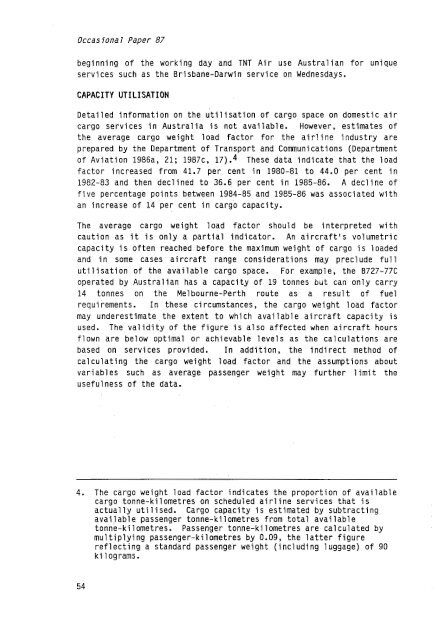Domestic Air Cargo Industry in Australia - Bureau of Infrastructure ...
Domestic Air Cargo Industry in Australia - Bureau of Infrastructure ...
Domestic Air Cargo Industry in Australia - Bureau of Infrastructure ...
Create successful ePaper yourself
Turn your PDF publications into a flip-book with our unique Google optimized e-Paper software.
Occasional Paper 87beg<strong>in</strong>n<strong>in</strong>g <strong>of</strong> the work<strong>in</strong>g day and TNT <strong>Air</strong> use <strong>Australia</strong>n for uniqueservices such as the Brisbane-Darw<strong>in</strong> service on Wednesdays.CAPACITY UTILISATIONDetailed <strong>in</strong>formation on the utilisation <strong>of</strong> cargo space on domestic aircargo services <strong>in</strong> <strong>Australia</strong> is not available. However, estimates <strong>of</strong>the average cargo weight load factor for the airl<strong>in</strong>e <strong>in</strong>dustry areprepared by the Department <strong>of</strong> Transport and Comnunications (Department<strong>of</strong> Aviation 1986a, 21; 1987c, 17).4 These data <strong>in</strong>dicate that the loadfactor <strong>in</strong>creased from 41.7 per cent <strong>in</strong> 1980-81 to 44.0 p.er cent <strong>in</strong>1982-83 and then decl<strong>in</strong>ed to 36.6 per cent <strong>in</strong> 1985-86. A decl <strong>in</strong>e <strong>of</strong>five percentage po<strong>in</strong>ts between 1984-85 and 1985-86 was associated withan <strong>in</strong>crease <strong>of</strong> 14 per cent <strong>in</strong> cargo capacity.The average cargo weight load factor should be <strong>in</strong>terpreted withcaution as it is only a partial <strong>in</strong>dicator. An aircraft's volumetriccapacity is <strong>of</strong>ten reached before the maximum weight <strong>of</strong> cargo is loadedand <strong>in</strong> some cases aircraft range considerations may preclude fullutilisation <strong>of</strong> the available cargo space. For example, the 8727-77Coperated by <strong>Australia</strong>n has a capacity <strong>of</strong> 19 tonnes but can only carry14 tonnes on the Melbourne-Perth route as a result <strong>of</strong> fuelrequirements. In these circumstances, the cargo weight load factormay underestimate the extent to which available aircraft capacity isused. The validity <strong>of</strong> the figure is also affected when aircraft hoursflown are below optimal or achievable levels as the calculations arebased on services provided.In addition, the <strong>in</strong>direct method <strong>of</strong>calculat<strong>in</strong>g the cargo weight load factor and the assumptions aboutvariables such as average passenger weight may further limit theusefulness <strong>of</strong> the data.4. The cargo weight load factor <strong>in</strong>dicates the proportion <strong>of</strong> availablecargo tonne-kilometres on scheduled airl<strong>in</strong>e services that isactually utilised. <strong>Cargo</strong> capacity is estimated by subtract<strong>in</strong>gavailable passenger tonne-kilometres from total availabletonne-kilometres. Passenger tonne-kilometres are calculated bymultiply<strong>in</strong>g passenger-kilometres by 0.09, the latter figurereflect<strong>in</strong>g a standard passenger weight (<strong>in</strong>clud<strong>in</strong>g 1 uggage) <strong>of</strong> 90ki 1 ograms.54
















